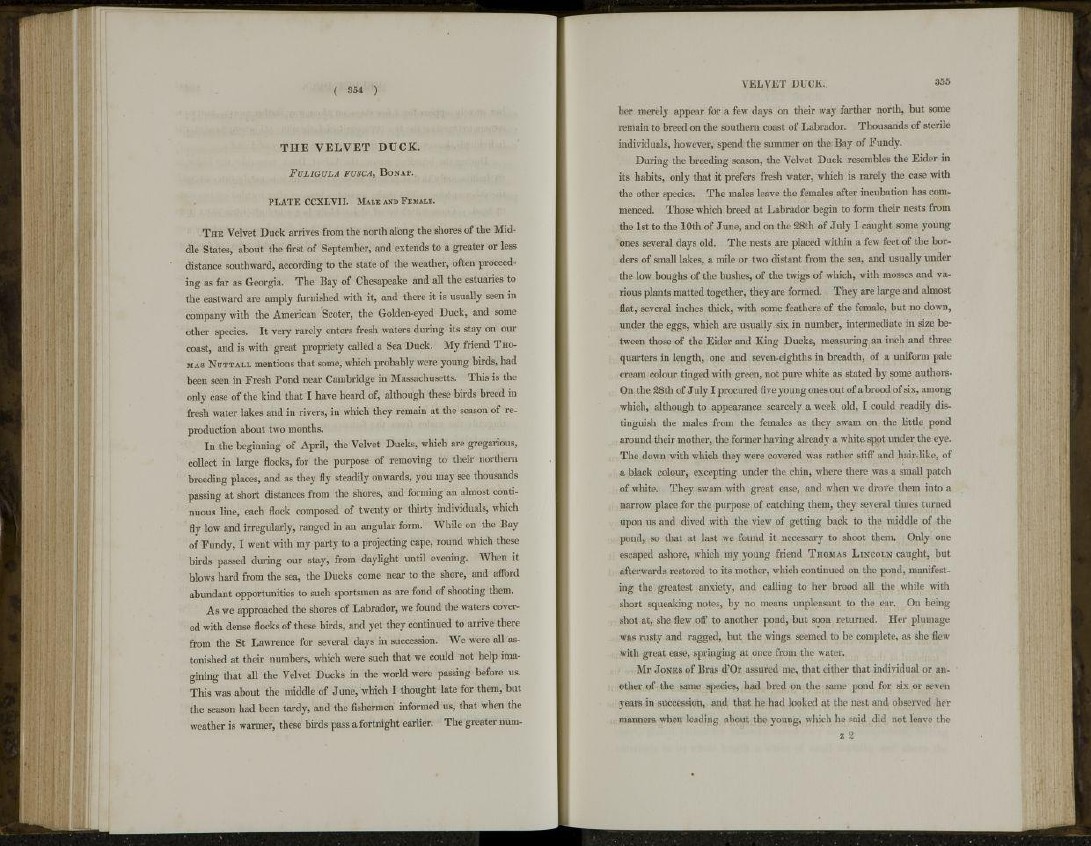
T H E V E L V E T D U C K.
FULIGULA FUSCA, BoNAP.
PLATE CCXLVII. MALE AND FEMALE.
T H E Velvet Duck arrives from the north along the shores of the Middle
States, about the first of September, and extends to a greater or less
distance southward, according to the state of the weather, often proceeding
as far as Georgia. The Bay of Chesapeake and all the estuaries to
the eastward are amply furnished with it, and there it is usually seen in
company with the American Scoter, the Golden-eyed Duck, and some
other species. It very rarely enters fresh waters during its stay on our
coast, and is with great propriety called a Sea Duck. My friend THOMAS
NOTTALL mentions that some, which probably were young birds, had
been seen in Fresh Pond near Cambridge in Massachusetts. This is the
only case of the kind that I have heard of, although these birds breed in
fresh water lakes and in rivers, in which they remain at the season of reproduction
about two months.
In the beginning of April, the Velvet Ducks, which are gregarious,
collect in large flocks, for the purpose of removing to their northern
breeding places, and as they fly steadily onwards, you may see thousands
passing at short distances from the shores, and forming an almost continuous
line, each flock composed of twenty or thirty individuals, which
fly low and irregularly, ranged in an angular form. While on the Bay
of Fundy, I went with my party to a projecting cape, round which these
birds passed during our stay, from daylight until evening. When it
blows hard from the sea, the Ducks come near to the shore, and afford
abundant opportunities to such sportsmen as are fond of shooting them.
As we approached the shores of Labrador, we found the waters covered
with dense flocks of these birds, and yet they continued to arrive there
from the St Lawrence for several days in succession. We were all astonished
at their numbers, which were such that we could not help imagining
that all the Velvet Ducks in the world were passing before us.
This was about the middle of June, which I thought late for them, but
the season had been tardy, and the fishermen informed us, that when the
weather is warmer, these birds pass a fortnight earlier. The greater number
merely appear for a few days on their way farther north, but some
remain to breed on the southern coast of Labrador. Thousands of sterile
individuals, however, spend the summer on the Bay of Fundy.
During the breeding season, the Velvet Duck resembles the Eider in
its habits, only that it prefers fresh water, which is rarely the case with
the other species. The males leave the females after incubation has commenced.
Those which breed at Labrador begin to form their nests from
the 1st to the 10th of June, and on the 28th of July I caught some young
ones several days old. The nests are placed within a few feet of the borders
of small lakes, a mile or two distant from the sea, and usually under
the low boughs of the bushes, of the twigs of which, with mosses and various
plants matted together, they are formed. They are large and almost
flat, several inches thick, with some feathers of the female, but no down,
under the eggs, which are usually six in number, intermediate in size between
those of the Eider and King Ducks, measuring an inch and three
quarters in length, one and seven-eighths in breadth, of a uniform pale
cream colour tinged with green, not pure white as stated by some authors.
On the 28th of July I procured five young ones out of a brood of six, among
which, although to appearance scarcely a week old, I could readily distinguish
the males from the females as they swam on the little pond
around their mother, the former having already a white, spot under the eye.
The down with which they were covered was rather stiff and hair-like, of
a black colour, excepting under the chin, where there was a small patch
of white. They swam with great ease, and when we drove them into a
narrow place for the purpose of catching them, they several times turned
upon us and dived with the view of getting back to the middle of the
pond, so that at last we found it necessary to shoot them. Only one
escaped ashore, which my young friend THOMAS LINCOLN caught, but
afterwards restored to its mother, which continued on the pond, manifesting
the greatest anxiety, and calling to her brood all the while with
short squeaking notes, by no means unpleasant to the ear. On being
shot at, she flew off to another pond, but soon returned. Her plumage
was rusty and ragged, but the wings seemed to be complete, as she flew
with great ease, springing at once from the water.
Mr JONES of Bras d'Or assured me, that cither that individual or another
of the same species, had bred on the same pond for six or seven
years in succession, and that he had looked at the nest and observed her
manners when leading about the young, which he said did not leave the
z 2